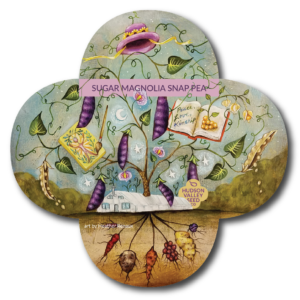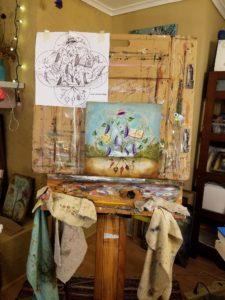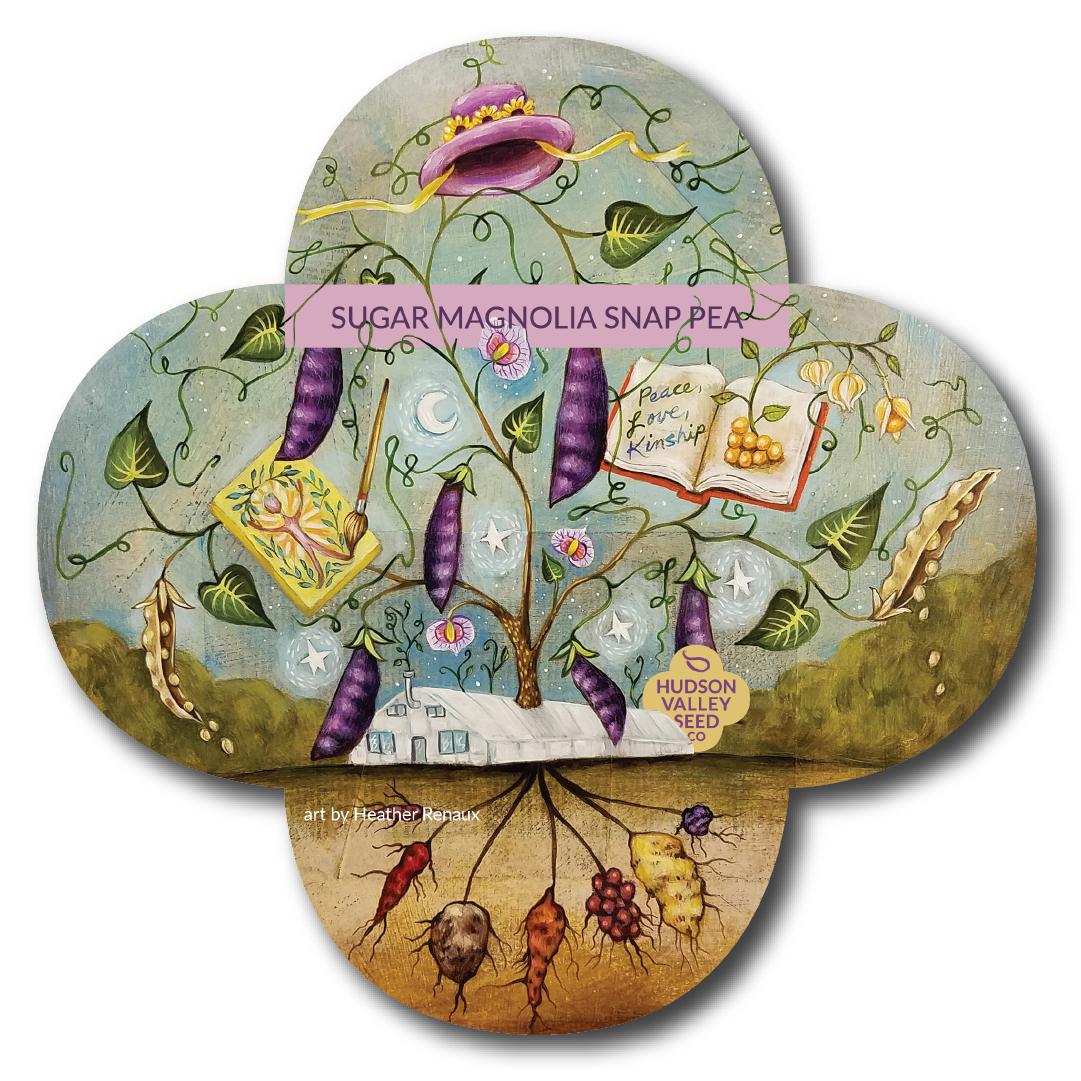 Oregon farmer and free thinker Alan Kapuler, aka Mushroom, has been growing, saving, and breeding new open-pollinated plants through Peace Seeds for decades, and he is one of our seed heroes. We are deeply grateful for his writing and his breeding work, and he has been a huge inspiration to us in our own endeavors.
Oregon farmer and free thinker Alan Kapuler, aka Mushroom, has been growing, saving, and breeding new open-pollinated plants through Peace Seeds for decades, and he is one of our seed heroes. We are deeply grateful for his writing and his breeding work, and he has been a huge inspiration to us in our own endeavors.
His varieties, like the twisting, outstretched hyper-tendrils of this purple sugar snap pea, have become intertwined with multiple generations of his family tree: his children are also seedspeople. Deciding on the artwork for this variety, the idea of a family tree quickly took root as we thought about the importance of Alan's work to the seed movement that we're part of, and its legacy, continued both by his children and those he inspires around him.
 Artist Heather Renaux
Artist Heather RenauxWhen we first discovered artist Heather Renaux, we were immediately captivated by her family trees. Based in her Minneapolis studio, she disappears into circus tents, dips beneath turbulent sea waters, and slips into story nests inhabited by magical fauna. To create her Sugar Magnolia Snap Pea artwork, Heather interviewed Alan Kapuler before crafting this acrylic-on-board custom family tree, which weaves together the story of this variety with that of his own family. Each branch carries elements that are significant to his work and life. We sat down with Heather to ask her how she created this unique family tree and what is was like to meet Alan Kapuler.
Heather, you told us that most days you feel like the luckiest woman alive because you're living your dream of being a full-time artist. Why do you make art? "I make art as a way of connecting to my spirituality, other humans and the world at large. Art gives me a way to understand life and also a way for others to understand me. I saw a piece of art recently that said, “there is really no difference between art and prayer.” That felt very true to me."
 How do you make your family trees? "I try to tell a family’s story. The family provides me with a list of “highlights” for every person and pet they would like to include. From that list, I come up with the images that I think will work best. Portraits are rarely included, so the story is told with these highlights. There is a lot of collaboration, which I hope is a really fun process for the families."
How do you make your family trees? "I try to tell a family’s story. The family provides me with a list of “highlights” for every person and pet they would like to include. From that list, I come up with the images that I think will work best. Portraits are rarely included, so the story is told with these highlights. There is a lot of collaboration, which I hope is a really fun process for the families."
What was it like to interview Alan Kapular for this project? "After our interview, I couldn’t help but feel that Dr. Kapuler is the purest of human, striving to give much more back to the Earth, humanity, Mother Nature than he will ever take. The moon in the sky represents him and the four stars in the sky represent his wife and three daughters. This reference is from an interview where he talks about all things being billions of years old, virtually stardust. This idea has actually been the inspiration of several paintings that I have done since my interview with him.
I would be over-the-moon happy if some viewers were intrigued enough to research the story of Dr. Alan “Mushroom” Kapuler and his amazing work! Hopefully my design will inspire people to plant these seeds and actually be able to benefit from Dr. Kapuler’s extensive efforts in developing them."
 What are your favorite elements of this piece? "I love the Andean tubers (which have been a large part of Dr. Kapuler’s work) growing under the Kinship Garden Greenhouse. In the tree’s viney limbs there is a book representing Dr. Kapuler’s prolific writings. The book has the words “Peace, Love, Kinship” written on one page. These words represent a huge part of what Dr. Kapuler considers his mission. To me, he seems to be the embodiment of these ideas. On the other page of the book, you will see a Giant Groundcherry (a Super Food) growing out of the page. “The Giant Groundcherry” is a chapter in the Lost Crops of the Incas by the National Research Council published ca.1987 that he edited. The editing of this chapter led him to his work with the Andean tubers."
What are your favorite elements of this piece? "I love the Andean tubers (which have been a large part of Dr. Kapuler’s work) growing under the Kinship Garden Greenhouse. In the tree’s viney limbs there is a book representing Dr. Kapuler’s prolific writings. The book has the words “Peace, Love, Kinship” written on one page. These words represent a huge part of what Dr. Kapuler considers his mission. To me, he seems to be the embodiment of these ideas. On the other page of the book, you will see a Giant Groundcherry (a Super Food) growing out of the page. “The Giant Groundcherry” is a chapter in the Lost Crops of the Incas by the National Research Council published ca.1987 that he edited. The editing of this chapter led him to his work with the Andean tubers."
We love how beautifully Heather has captured the story of this family tree, how it unfolds to reveal the work of a great seed breeder and this sweet crunch of a snap pea. May it provide food for our imagination and nourishment for our souls.
See more of Heather's work at www.heatherrenaux.com/
How to Grow Sugar Magnolia Snap Pea
| Days to Maturity | 70 days |
|---|---|
| Planting Depth | 1 inch |
| Spacing in Row | 3 inches |
| Spacing Between Rows | 18 inches |
| Height at Maturity | 84 inches |
Peas are fun, fast, and can be sown at the first sign of spring. The pea shoots and climbing tendril-festooned vines keep you company throughout the many spring garden tasks--and provide beautiful flowers and delicious snappy crunchy bursts of summer's-finally-here. Peas love cool weather, so sow them the first or second week of April here in the Northeast. You can probably get away with plantings up to early May, but after this you're best off waiting until mid-summer (for a fall crop) or next spring. Soak peas overnight, inoculate them, and then sow them in rows (or double rows, or even more) about one or two inches apart. Sow them deeply--between one and two inches below the surface.
While you're waiting for the first tendrils to emerge through the moist spring soil (what joy!), be sure to provide a trellis up which the young plants will quickly climb. You can use string and 2x2 posts spaced every ten feet, or you can use chicken wire. Peas are ready to harvest in late June and early to mid July. Sow snow peas in late July for a fall crop; other varieties rarely do well at that time of year.





